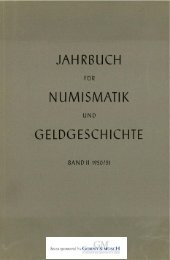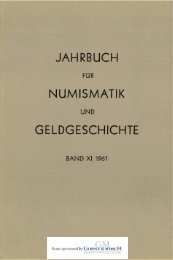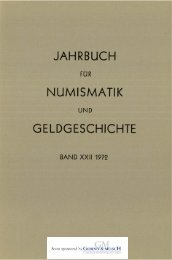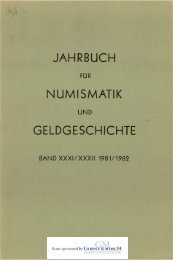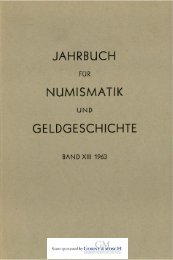32 Peter F. Dorceycoinage. Accordingly, 281 is the terminus post quem for the new series atOdessos.The type is familiar to the numismatist: Alexander the Great appears onthe obverse in the guise of Herakles wearing the Nemean lion scalp; thereverse displays a seated Zeus enthroned between the legends BAEIAES2EAAEE,ANAPOY. At first the monogram for Odessos, or 0, appearseither below the deity's throne or in the left field. Later the monogram isexpanded to OAH, and in one instance to OAHEITQN. No pictorial Symbolwas used to indicate Odessos, unless the spear (?) on a reverse die of themoneyer acted as a mintmark (pl. 5, no. 3).From the beginning, officials' names appear in the field or exergue of thereverse. It is unclear whether these names represent moneyers, eponymouspriests4 or other local officials. We know almost nothing of Odessos' internalpolitical structure. The monograms or abbreviated names of these individualsappear consistently on silver until minting stopped sometimebefore 50, when Odessos was captured and destroyed by the Getae, providinga firm terminus ante quem for the city's Hellenistic coinage.The twenty-one magistrates who appear on the tetradrachm issue must befitted into a 231 year period beginning in 281.5 Obviously coinage was notannual if a yearly election of officials is assumed. Rather, minting was irregularand highly infrequent throughout since each moneyer coined onlyonce. Some seem to have issued bronze and gold (with different types) in additionto silver.6On the basis of hoard evidence, artistic style and die linkage, twochronological groups can be recognized, perhaps separated by a hiatus inminting activities. The earliest coins are classical in design and include thefollowing eleven moneyers (Group I): K , KOI, KYPIA, KAEAN, er4 Pick-Regling, op. cit., 522, notes a possible correspondence between some of the moneyers'names on this issue and those of priests on an inscription found at Odessos (G. Mihailov,Inscriptiones Graecae in Bulgaria Repertae (Sophia 1970) I, 103-106, no. 46 (hence forthcited as IG Bulg). Both sets of names, however, are too abbreviated to make any identificationabsolute.5 I do not follow Price's attribution of OEOYME and N( to Odessos. The latter is die linked(with ANS coins) with AFIOAA, I1PO and e at Messembria. Pick-Regling recordsall moneyers except iy and e.6The abbreviated names or monograms of these magistrates cannot always be distinguishedfrom one another. EY and EYIIPO, and OE and ()EM(I) may represent the samemoneyers, although distinctive styles suggest different magistrates issuing years apart fromone another.e, AH, OE and AFA are moneyers found also on copper issues of Odessos: see Pick-Regling, op. cit., 542, no. 2182; 546, no. 2199; 545, no. 2195; 550, nos. 2216-2218. KOI andKAEAN also appear on gold staters with the posthumous portrait of Alexander issued inthe narre of Lysimachus at Odessos: see Pick-Regling, op. cit., 530, nos. 2119-2122; 532,nos. 2133-2134.
Posthumous Alexander Tetradrachms of Odessos 33AE, WP, A, N, 4, and EY. The Romania Hoard indicates that K ,KOI and KAEAN issued before 190.7 The Mektepini deposit confirms thisdating for KOI and KAEAN issuers, as do the Malomir and Latakia hoardsfor KOI.8 K , KOI and KAEAN probably represent the earliest issues ofAlexander tetradrachms at Odessos.The coins of these three magistrates are very similar in design: the flan isthicker and Herakles' head larger than on later issues (pl. 5, nos. 1-2). KYP-EA and KI also exhibit similar large flan and head sizes. The sole KYPEAobverse die bears a close resemblance to one of KAEAN in regard to thetreatment of Herakles' hair, lion's scalp and head.9 Possibly the same dieengraver was at work. A die of KI is nearly identical to a KOI obverse diewhich depicts the claws of Herakles' lion's scalp as four short horizontal bars(pl. 5, no. 2). This same unique artistic device is seen again only on an obversedie shared by the magistrates q, AE and WP (pl. 5, no. 3). The lastmoneyer in this triple die link is surely the most recent, as a tiny die breakin the right field proves. This die-linked set appears a bit later than thepreviously mentioned issues, for it was executed in a more „degenerate" stylemarked by a reduced flan size and a smaller Herakles head.EFT (Paris), N and, 21 which share the same obverse die, are even laterin date, if the rule hol s true that mint style goes from good to bad. Thisdie exhibits a crude, but still classical style. Lessi t\ention is paid to detailsof Alexander's hair and the flan is very small. is similar in style, butmore refined and less „barbaric." Therefore, it seems to date earlier than thetwo die-linked groups. EY(IIPO) probably comes last in this first group ofeleven magistrates, to judge from stylistic criteria alone (pl. 5, no. 4).It is difficult to postulate an absolute chronology for Group I, especiallyfor the eight minters whose coins are not found in any hoards. Apparently,all dies in question, except possibly the last, dated no later than 175-150.The remaining ten magistrates (Group II) can be categorized into two setson the basis of style, hoards and die linkage. AH, ./9, 0E, and AI'A comebefore 120, while OEM(I), EKA, AAKQN, EETI(AI), HPAKAEOYE andEENO fall after that date. The Trastikovo hoard, containing issues of AH,72, and OE, may push the cut-off date as early as 125; however, the Sumendeposit, with issues AH and 0E, provides a more conservative terminus ante7 M. Thompson, C. Kraay and 0. Merkholm, An Inventory of Greek Coin Hoards (NewYork 1973) no. 886 (henceforth cited as IGCH).8 N. Olcay and H. Seyrig, Le Tresor de Mektepini en Phrygie (Paris 1965) nos. 5-7; IGCHno. 887. H. Seyrig, Tresors du Levant anciens et nouveaux (Paris 1973) 30.9 Note that KYPEA is probably the same magistrate who issued the tetradrachm type bearingthe legend 0E0Y MEFAAOY OAH[EITQN]: see B.V. Head, Historia Numorum (Oxford1887) 236, who regards KYPEA as Thracian, not Greek.
- Seite 1: JAHRBUCHFÜRNUMISMATIKUNDGELDGESCHI
- Seite 5 und 6: JAHRBUCHFÜRNUMISMATIK UND GELDGESC
- Seite 7 und 8: INHALTVorbemerkung der Redaktion 7G
- Seite 9: 7Vorbemerkung der RedaktionEntgegen
- Seite 12 und 13: 10 Gerd DethlefsDie Zeichnung befin
- Seite 14 und 15: 12 J.Elayi, A.G.Elayiexplicit inscr
- Seite 16: 14 J. Elayi, A.G.Elayione bears on
- Seite 19 und 20: Abbreviations Used by Byblos,Tyre a
- Seite 21 und 22: Abbreviations Used by Byblos,Tyre a
- Seite 23 und 24: Abbreviations Used by Byblos,Tyre a
- Seite 25 und 26: Jahrbuch f. Numismatik u. Geldgesch
- Seite 27 und 28: Significance of „Boiotian League/
- Seite 29 und 30: Significance of „Boiotian League/
- Seite 31: Significance of „Boiotian League/
- Seite 36 und 37: 34 Peter F. Dorceyquem of 120.'° A
- Seite 38 und 39: 36 Peter F.DorceyEETI(AI)2° and HP
- Seite 40 und 41: 38 Peter F. DorceyTable I: Catalogu
- Seite 42 und 43: 40 Peter F.DorceyTable II: Coin Hoa
- Seite 44 und 45: 42 Allan A. LundDer Germanenbegriff
- Seite 46 und 47: 44 Allan A. Lundnen sie, wie die Fo
- Seite 48 und 49: 46 Allan A. Lunddie Angaben über d
- Seite 50 und 51: 48 Allan A. Lundw a 200 Kilometer b
- Seite 52 und 53: 50 Allan A. Lundrelle Grenze fielen
- Seite 55 und 56: Jahrbuch f. Numismatik u. Geldgesch
- Seite 57 und 58: Ein weiterer Aureus des Pescennius
- Seite 59 und 60: Jahrbuch f. Numismatik u. Geldgesch
- Seite 61 und 62: 1Bronzeprägung von Laodikeia in Sy
- Seite 63 und 64: Bronzeprägung von Laodikeia in Syr
- Seite 65 und 66: Bronzeprägung von Laodikeia in Syr
- Seite 67 und 68: Bronzeprägung von Laodikeia in Syr
- Seite 69 und 70: Bronzeprägung von Laodikeia in Syr
- Seite 71 und 72: Bronzeprägung von Laodikeia in Syr
- Seite 73 und 74: Bronzeprägung von Laodikeia in Syr
- Seite 75 und 76: Bronzeprägung von Laodikeia in Syr
- Seite 77 und 78: Bronzeprägung von Laodikeia in Syr
- Seite 79 und 80: Bronzeprägung von Laodikeia in Syr
- Seite 81 und 82: Bronzeprägung von Laodikeia in Syr
- Seite 83 und 84: Bronzeprägung von Laodikeia in Syr
- Seite 85 und 86:
Bronzeprägung von Laodikeia in Syr
- Seite 87 und 88:
Bronzeprägung von Laodikeia in Syr
- Seite 89 und 90:
Bronzeprägung von Laodikeia in Syr
- Seite 91 und 92:
Bronzeprägung von Laodikeia in Syr
- Seite 93 und 94:
Bronzeprägung von Laodikeia in Syr
- Seite 95 und 96:
Jahrbuch f. Numismatik u. Geldgesch
- Seite 97 und 98:
Zwei Bleigewichte in München 95mei
- Seite 99 und 100:
Zwei Bleigewichte in München 97Val
- Seite 101 und 102:
Zwei Bleigewichte in München 99nö
- Seite 103 und 104:
Jahrbuch f. Numismatik u. Geldgesch
- Seite 105 und 106:
Saalfeld als Münzstätte der Leini
- Seite 107 und 108:
Saalfeld als Münzstätte der Leini
- Seite 109 und 110:
Saalfeld als Münzstätte der Leini
- Seite 111 und 112:
Saalfeld als Münzstätte der Leini
- Seite 113 und 114:
Saalfeld als Münzstätte der Leini
- Seite 115 und 116:
Saalfeld als Münzstätte der Leini
- Seite 117 und 118:
Saalfeld als Münzstätte der Leini
- Seite 119 und 120:
Saalfeld als Münzstätte der Leini
- Seite 121 und 122:
Saalfeld als Münzstätte der Leini
- Seite 123 und 124:
Saalfeld als Münzstätte der Leini
- Seite 125 und 126:
Saalfeld als Münzstätte der Leini
- Seite 127 und 128:
Saalfeld als Münzstätte der Leini
- Seite 129 und 130:
Saalfeld als Münzstätte der Leini
- Seite 131 und 132:
129ZUSAMMENFASSUNGEN(erstellt von B
- Seite 133 und 134:
Zusammenfassungen/Conclusions 131Ar
- Seite 135 und 136:
Jahrbuch f. Numismatik u. Geldgesch
- Seite 137 und 138:
Buchbesprechungen, Jb.f.Num.u.Geldg
- Seite 139 und 140:
Buchbesprechungen, Jb.f.Num.u.Geldg
- Seite 141 und 142:
Buchbesprechungen, Jb.f.Num.u.Geldg
- Seite 143:
Buchbesprechungen, Jb.f.Num.u.Geldg
- Seite 146 und 147:
144 Jahresbericht Staat!. Münzsamm
- Seite 149 und 150:
Jahrbuch f.Numismatik u. Geldgeschi
- Seite 151 und 152:
Jahresbericht B.N.G. 149Stadt lasse
- Seite 153:
Jahresbericht B.N.G. 151Band 35, k
- Seite 156 und 157:
154 Jahresbericht B.N.G.der Heimat
- Seite 158 und 159:
156 Jahresbericht B.N.G.Medaillen"
- Seite 161 und 162:
vyaltoti9er canyexitift, _s,9t.czr
- Seite 163 und 164:
Tafel 3123Zu: J. und A.G. Elayi, Sy
- Seite 165:
Tafel 5Zu: Peter F. Dorcey, The Pos
- Seite 169 und 170:
Zu: Eckhard Meyer, Die Bronzeprägu
- Seite 171 und 172:
Elf el 949Zu: Eckhard Meyer, Die Br
- Seite 173 und 174:
Zu: Eckhard Meyer, Die Bronzeprägu
- Seite 175 und 176:
Zu: Eckhard Meyer, Die Bronzeprägu
- Seite 177 und 178:
Zu: Eckhard Meyer, Die Bronzeprägu
- Seite 179 und 180:
Zu: Eckhard Meyer, Die Bronzeprägu
- Seite 181 und 182:
Tafel 19Maßstab:1 : 1Foto: Staatl.
- Seite 183 und 184:
Tafel 211 2 34 5. , )(4. ' cili li





